Child Labour in Australia: A Human Rights Analysis and Solutions
VerifiedAdded on 2023/04/21
|8
|2671
|428
Essay
AI Summary
This essay examines the issue of child labour in Australia, highlighting its historical context, current prevalence, and impact on children's human rights. It discusses how child labour, including instances of child slavery, affects the mental and physical well-being of children, particularly Aboriginal and Torres Strait Islander children, often referred to as the "stolen generation." The essay explores arguments for and against child labour, referencing the International Labour Organization (ILO) and the United Nations' Rights of the Child Act. It also touches upon examples from other countries like Africa, Brazil, Britain, and India. The essay concludes by emphasizing the need for government and non-government organizations to collaborate in eradicating child labour, promoting education, and enforcing fair trade practices to protect children and secure their future.
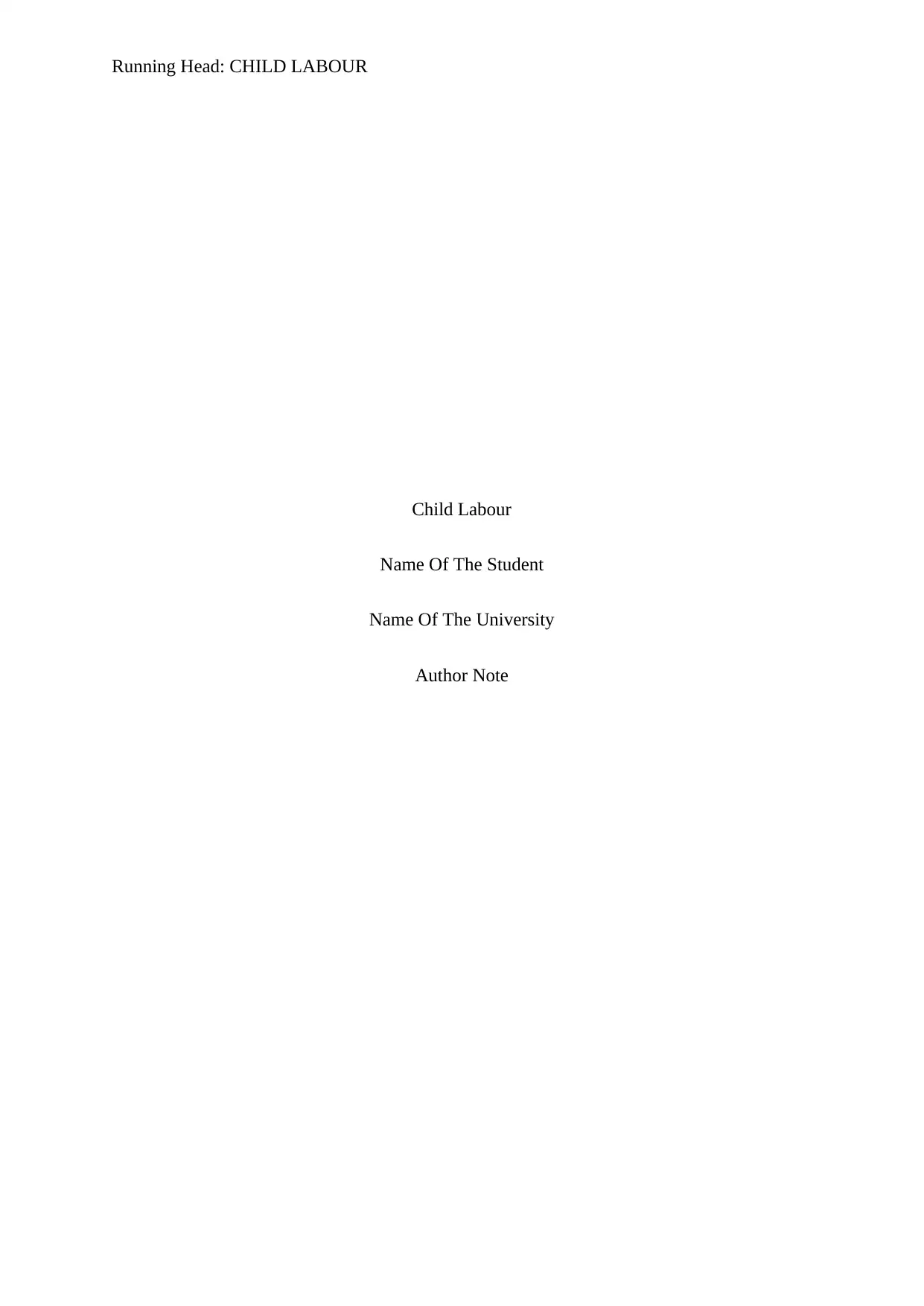
Running Head: CHILD LABOUR
Child Labour
Name Of The Student
Name Of The University
Author Note
Child Labour
Name Of The Student
Name Of The University
Author Note
Paraphrase This Document
Need a fresh take? Get an instant paraphrase of this document with our AI Paraphraser
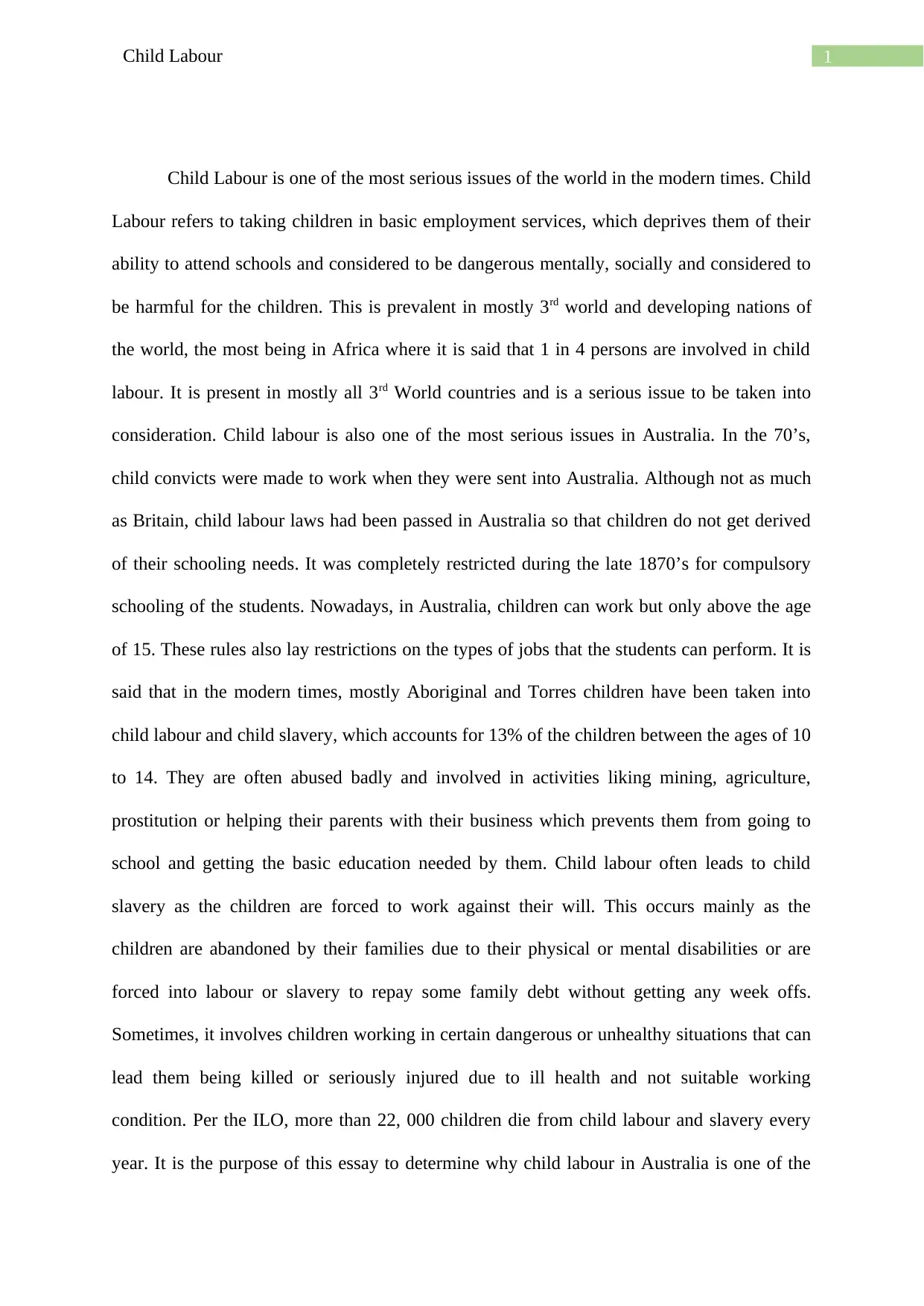
1Child Labour
Child Labour is one of the most serious issues of the world in the modern times. Child
Labour refers to taking children in basic employment services, which deprives them of their
ability to attend schools and considered to be dangerous mentally, socially and considered to
be harmful for the children. This is prevalent in mostly 3rd world and developing nations of
the world, the most being in Africa where it is said that 1 in 4 persons are involved in child
labour. It is present in mostly all 3rd World countries and is a serious issue to be taken into
consideration. Child labour is also one of the most serious issues in Australia. In the 70’s,
child convicts were made to work when they were sent into Australia. Although not as much
as Britain, child labour laws had been passed in Australia so that children do not get derived
of their schooling needs. It was completely restricted during the late 1870’s for compulsory
schooling of the students. Nowadays, in Australia, children can work but only above the age
of 15. These rules also lay restrictions on the types of jobs that the students can perform. It is
said that in the modern times, mostly Aboriginal and Torres children have been taken into
child labour and child slavery, which accounts for 13% of the children between the ages of 10
to 14. They are often abused badly and involved in activities liking mining, agriculture,
prostitution or helping their parents with their business which prevents them from going to
school and getting the basic education needed by them. Child labour often leads to child
slavery as the children are forced to work against their will. This occurs mainly as the
children are abandoned by their families due to their physical or mental disabilities or are
forced into labour or slavery to repay some family debt without getting any week offs.
Sometimes, it involves children working in certain dangerous or unhealthy situations that can
lead them being killed or seriously injured due to ill health and not suitable working
condition. Per the ILO, more than 22, 000 children die from child labour and slavery every
year. It is the purpose of this essay to determine why child labour in Australia is one of the
Child Labour is one of the most serious issues of the world in the modern times. Child
Labour refers to taking children in basic employment services, which deprives them of their
ability to attend schools and considered to be dangerous mentally, socially and considered to
be harmful for the children. This is prevalent in mostly 3rd world and developing nations of
the world, the most being in Africa where it is said that 1 in 4 persons are involved in child
labour. It is present in mostly all 3rd World countries and is a serious issue to be taken into
consideration. Child labour is also one of the most serious issues in Australia. In the 70’s,
child convicts were made to work when they were sent into Australia. Although not as much
as Britain, child labour laws had been passed in Australia so that children do not get derived
of their schooling needs. It was completely restricted during the late 1870’s for compulsory
schooling of the students. Nowadays, in Australia, children can work but only above the age
of 15. These rules also lay restrictions on the types of jobs that the students can perform. It is
said that in the modern times, mostly Aboriginal and Torres children have been taken into
child labour and child slavery, which accounts for 13% of the children between the ages of 10
to 14. They are often abused badly and involved in activities liking mining, agriculture,
prostitution or helping their parents with their business which prevents them from going to
school and getting the basic education needed by them. Child labour often leads to child
slavery as the children are forced to work against their will. This occurs mainly as the
children are abandoned by their families due to their physical or mental disabilities or are
forced into labour or slavery to repay some family debt without getting any week offs.
Sometimes, it involves children working in certain dangerous or unhealthy situations that can
lead them being killed or seriously injured due to ill health and not suitable working
condition. Per the ILO, more than 22, 000 children die from child labour and slavery every
year. It is the purpose of this essay to determine why child labour in Australia is one of the
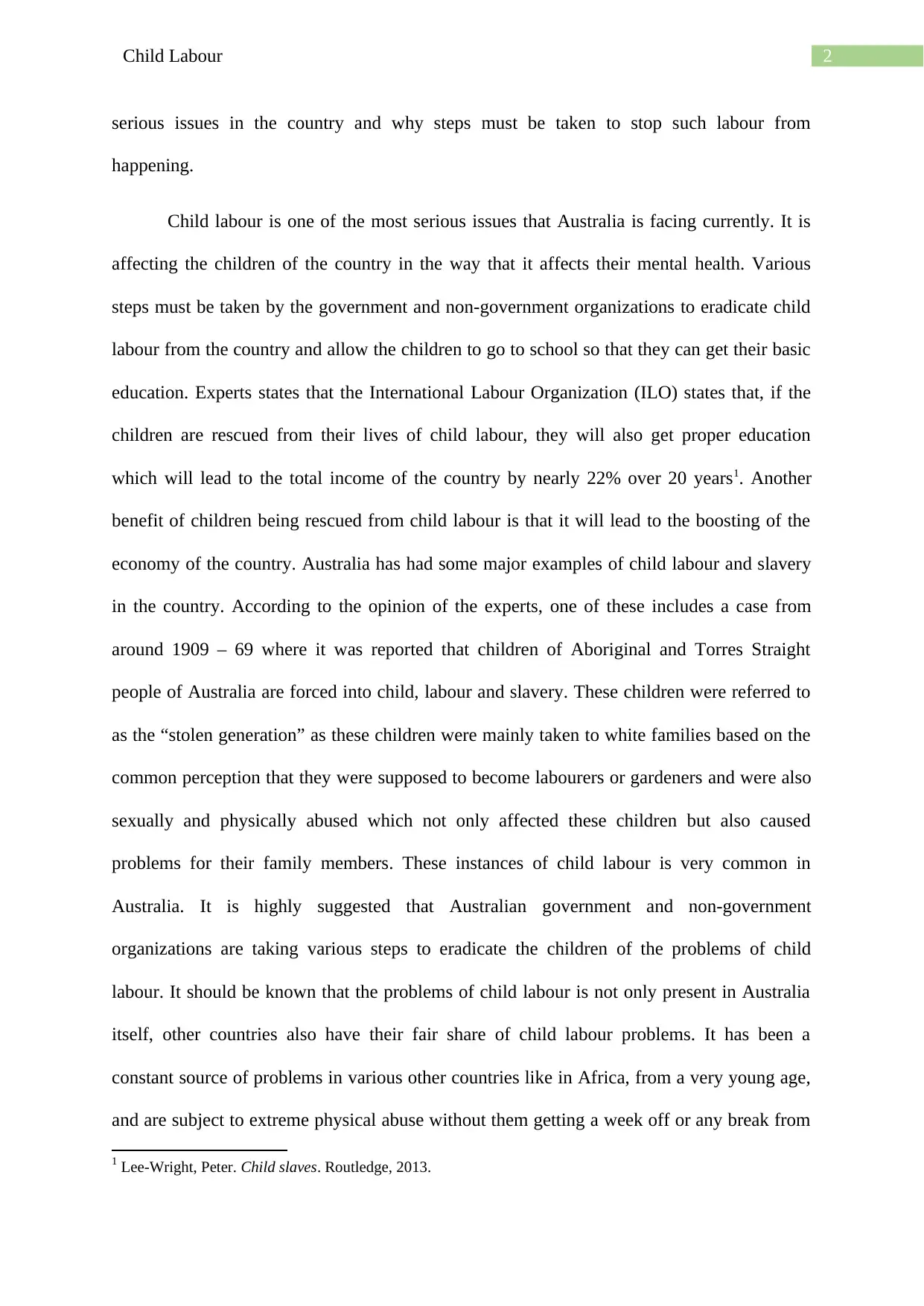
2Child Labour
serious issues in the country and why steps must be taken to stop such labour from
happening.
Child labour is one of the most serious issues that Australia is facing currently. It is
affecting the children of the country in the way that it affects their mental health. Various
steps must be taken by the government and non-government organizations to eradicate child
labour from the country and allow the children to go to school so that they can get their basic
education. Experts states that the International Labour Organization (ILO) states that, if the
children are rescued from their lives of child labour, they will also get proper education
which will lead to the total income of the country by nearly 22% over 20 years1. Another
benefit of children being rescued from child labour is that it will lead to the boosting of the
economy of the country. Australia has had some major examples of child labour and slavery
in the country. According to the opinion of the experts, one of these includes a case from
around 1909 – 69 where it was reported that children of Aboriginal and Torres Straight
people of Australia are forced into child, labour and slavery. These children were referred to
as the “stolen generation” as these children were mainly taken to white families based on the
common perception that they were supposed to become labourers or gardeners and were also
sexually and physically abused which not only affected these children but also caused
problems for their family members. These instances of child labour is very common in
Australia. It is highly suggested that Australian government and non-government
organizations are taking various steps to eradicate the children of the problems of child
labour. It should be known that the problems of child labour is not only present in Australia
itself, other countries also have their fair share of child labour problems. It has been a
constant source of problems in various other countries like in Africa, from a very young age,
and are subject to extreme physical abuse without them getting a week off or any break from
1 Lee-Wright, Peter. Child slaves. Routledge, 2013.
serious issues in the country and why steps must be taken to stop such labour from
happening.
Child labour is one of the most serious issues that Australia is facing currently. It is
affecting the children of the country in the way that it affects their mental health. Various
steps must be taken by the government and non-government organizations to eradicate child
labour from the country and allow the children to go to school so that they can get their basic
education. Experts states that the International Labour Organization (ILO) states that, if the
children are rescued from their lives of child labour, they will also get proper education
which will lead to the total income of the country by nearly 22% over 20 years1. Another
benefit of children being rescued from child labour is that it will lead to the boosting of the
economy of the country. Australia has had some major examples of child labour and slavery
in the country. According to the opinion of the experts, one of these includes a case from
around 1909 – 69 where it was reported that children of Aboriginal and Torres Straight
people of Australia are forced into child, labour and slavery. These children were referred to
as the “stolen generation” as these children were mainly taken to white families based on the
common perception that they were supposed to become labourers or gardeners and were also
sexually and physically abused which not only affected these children but also caused
problems for their family members. These instances of child labour is very common in
Australia. It is highly suggested that Australian government and non-government
organizations are taking various steps to eradicate the children of the problems of child
labour. It should be known that the problems of child labour is not only present in Australia
itself, other countries also have their fair share of child labour problems. It has been a
constant source of problems in various other countries like in Africa, from a very young age,
and are subject to extreme physical abuse without them getting a week off or any break from
1 Lee-Wright, Peter. Child slaves. Routledge, 2013.
⊘ This is a preview!⊘
Do you want full access?
Subscribe today to unlock all pages.

Trusted by 1+ million students worldwide
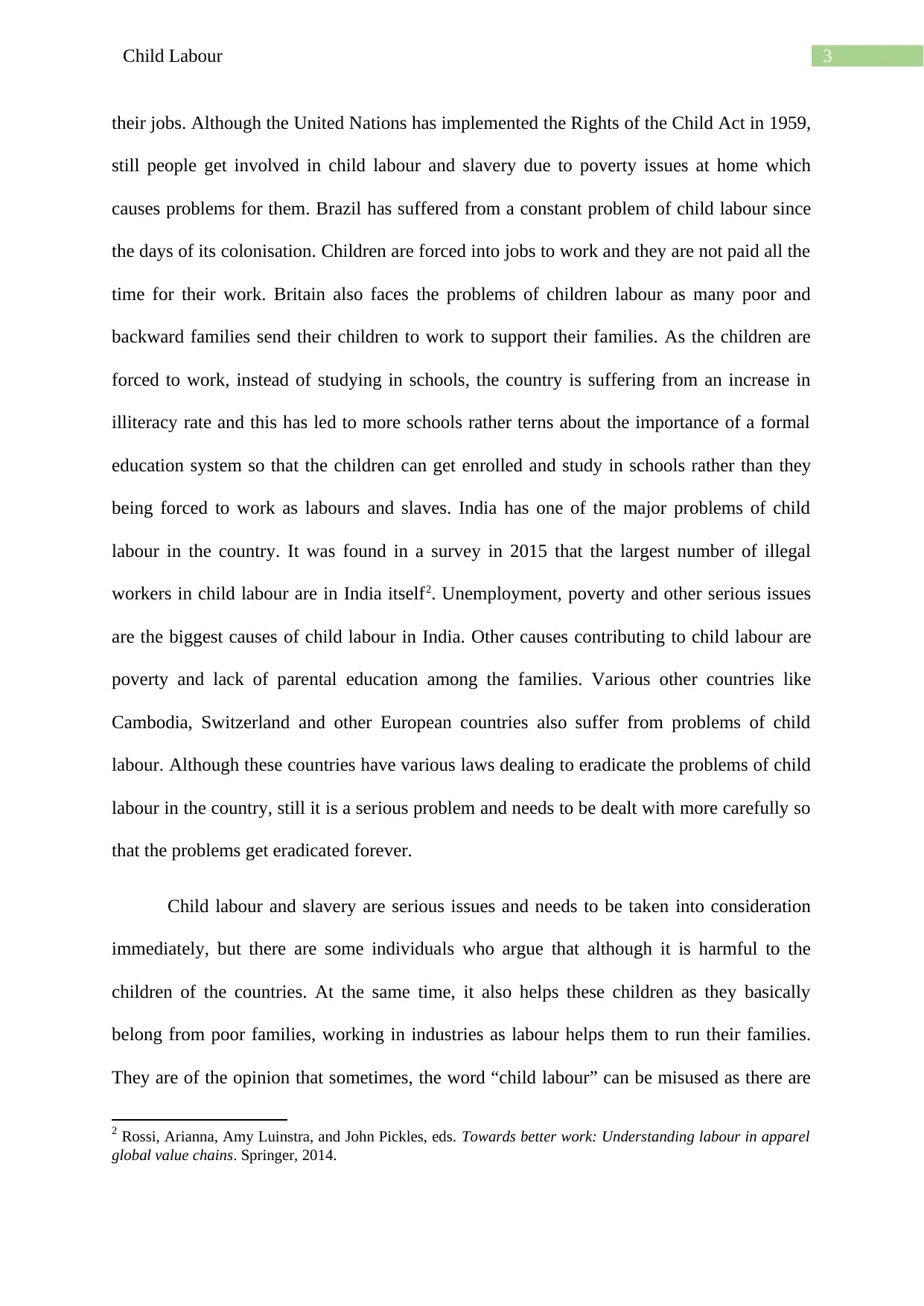
3Child Labour
their jobs. Although the United Nations has implemented the Rights of the Child Act in 1959,
still people get involved in child labour and slavery due to poverty issues at home which
causes problems for them. Brazil has suffered from a constant problem of child labour since
the days of its colonisation. Children are forced into jobs to work and they are not paid all the
time for their work. Britain also faces the problems of children labour as many poor and
backward families send their children to work to support their families. As the children are
forced to work, instead of studying in schools, the country is suffering from an increase in
illiteracy rate and this has led to more schools rather terns about the importance of a formal
education system so that the children can get enrolled and study in schools rather than they
being forced to work as labours and slaves. India has one of the major problems of child
labour in the country. It was found in a survey in 2015 that the largest number of illegal
workers in child labour are in India itself2. Unemployment, poverty and other serious issues
are the biggest causes of child labour in India. Other causes contributing to child labour are
poverty and lack of parental education among the families. Various other countries like
Cambodia, Switzerland and other European countries also suffer from problems of child
labour. Although these countries have various laws dealing to eradicate the problems of child
labour in the country, still it is a serious problem and needs to be dealt with more carefully so
that the problems get eradicated forever.
Child labour and slavery are serious issues and needs to be taken into consideration
immediately, but there are some individuals who argue that although it is harmful to the
children of the countries. At the same time, it also helps these children as they basically
belong from poor families, working in industries as labour helps them to run their families.
They are of the opinion that sometimes, the word “child labour” can be misused as there are
2 Rossi, Arianna, Amy Luinstra, and John Pickles, eds. Towards better work: Understanding labour in apparel
global value chains. Springer, 2014.
their jobs. Although the United Nations has implemented the Rights of the Child Act in 1959,
still people get involved in child labour and slavery due to poverty issues at home which
causes problems for them. Brazil has suffered from a constant problem of child labour since
the days of its colonisation. Children are forced into jobs to work and they are not paid all the
time for their work. Britain also faces the problems of children labour as many poor and
backward families send their children to work to support their families. As the children are
forced to work, instead of studying in schools, the country is suffering from an increase in
illiteracy rate and this has led to more schools rather terns about the importance of a formal
education system so that the children can get enrolled and study in schools rather than they
being forced to work as labours and slaves. India has one of the major problems of child
labour in the country. It was found in a survey in 2015 that the largest number of illegal
workers in child labour are in India itself2. Unemployment, poverty and other serious issues
are the biggest causes of child labour in India. Other causes contributing to child labour are
poverty and lack of parental education among the families. Various other countries like
Cambodia, Switzerland and other European countries also suffer from problems of child
labour. Although these countries have various laws dealing to eradicate the problems of child
labour in the country, still it is a serious problem and needs to be dealt with more carefully so
that the problems get eradicated forever.
Child labour and slavery are serious issues and needs to be taken into consideration
immediately, but there are some individuals who argue that although it is harmful to the
children of the countries. At the same time, it also helps these children as they basically
belong from poor families, working in industries as labour helps them to run their families.
They are of the opinion that sometimes, the word “child labour” can be misused as there are
2 Rossi, Arianna, Amy Luinstra, and John Pickles, eds. Towards better work: Understanding labour in apparel
global value chains. Springer, 2014.
Paraphrase This Document
Need a fresh take? Get an instant paraphrase of this document with our AI Paraphraser
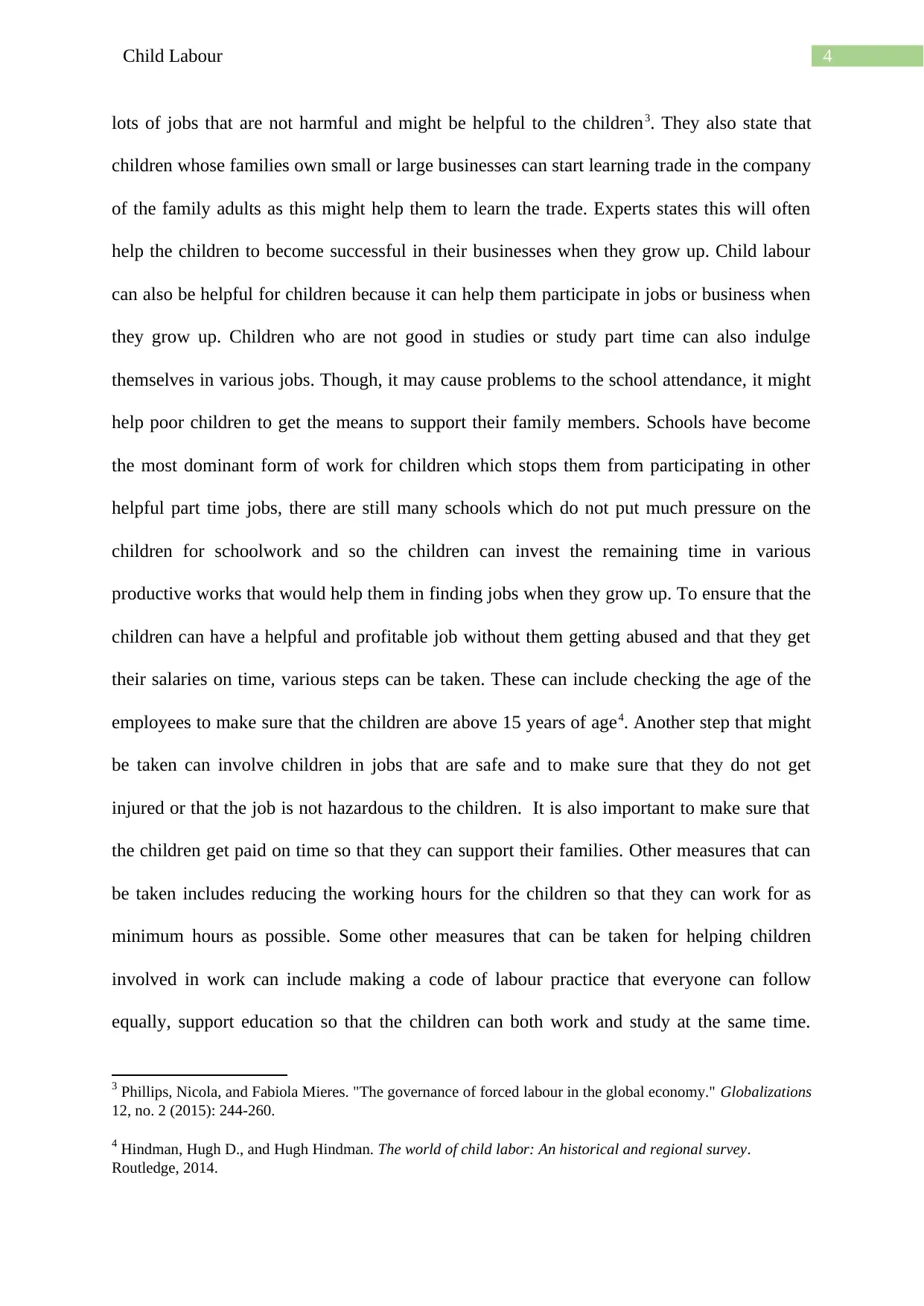
4Child Labour
lots of jobs that are not harmful and might be helpful to the children3. They also state that
children whose families own small or large businesses can start learning trade in the company
of the family adults as this might help them to learn the trade. Experts states this will often
help the children to become successful in their businesses when they grow up. Child labour
can also be helpful for children because it can help them participate in jobs or business when
they grow up. Children who are not good in studies or study part time can also indulge
themselves in various jobs. Though, it may cause problems to the school attendance, it might
help poor children to get the means to support their family members. Schools have become
the most dominant form of work for children which stops them from participating in other
helpful part time jobs, there are still many schools which do not put much pressure on the
children for schoolwork and so the children can invest the remaining time in various
productive works that would help them in finding jobs when they grow up. To ensure that the
children can have a helpful and profitable job without them getting abused and that they get
their salaries on time, various steps can be taken. These can include checking the age of the
employees to make sure that the children are above 15 years of age4. Another step that might
be taken can involve children in jobs that are safe and to make sure that they do not get
injured or that the job is not hazardous to the children. It is also important to make sure that
the children get paid on time so that they can support their families. Other measures that can
be taken includes reducing the working hours for the children so that they can work for as
minimum hours as possible. Some other measures that can be taken for helping children
involved in work can include making a code of labour practice that everyone can follow
equally, support education so that the children can both work and study at the same time.
3 Phillips, Nicola, and Fabiola Mieres. "The governance of forced labour in the global economy." Globalizations
12, no. 2 (2015): 244-260.
4 Hindman, Hugh D., and Hugh Hindman. The world of child labor: An historical and regional survey.
Routledge, 2014.
lots of jobs that are not harmful and might be helpful to the children3. They also state that
children whose families own small or large businesses can start learning trade in the company
of the family adults as this might help them to learn the trade. Experts states this will often
help the children to become successful in their businesses when they grow up. Child labour
can also be helpful for children because it can help them participate in jobs or business when
they grow up. Children who are not good in studies or study part time can also indulge
themselves in various jobs. Though, it may cause problems to the school attendance, it might
help poor children to get the means to support their family members. Schools have become
the most dominant form of work for children which stops them from participating in other
helpful part time jobs, there are still many schools which do not put much pressure on the
children for schoolwork and so the children can invest the remaining time in various
productive works that would help them in finding jobs when they grow up. To ensure that the
children can have a helpful and profitable job without them getting abused and that they get
their salaries on time, various steps can be taken. These can include checking the age of the
employees to make sure that the children are above 15 years of age4. Another step that might
be taken can involve children in jobs that are safe and to make sure that they do not get
injured or that the job is not hazardous to the children. It is also important to make sure that
the children get paid on time so that they can support their families. Other measures that can
be taken includes reducing the working hours for the children so that they can work for as
minimum hours as possible. Some other measures that can be taken for helping children
involved in work can include making a code of labour practice that everyone can follow
equally, support education so that the children can both work and study at the same time.
3 Phillips, Nicola, and Fabiola Mieres. "The governance of forced labour in the global economy." Globalizations
12, no. 2 (2015): 244-260.
4 Hindman, Hugh D., and Hugh Hindman. The world of child labor: An historical and regional survey.
Routledge, 2014.
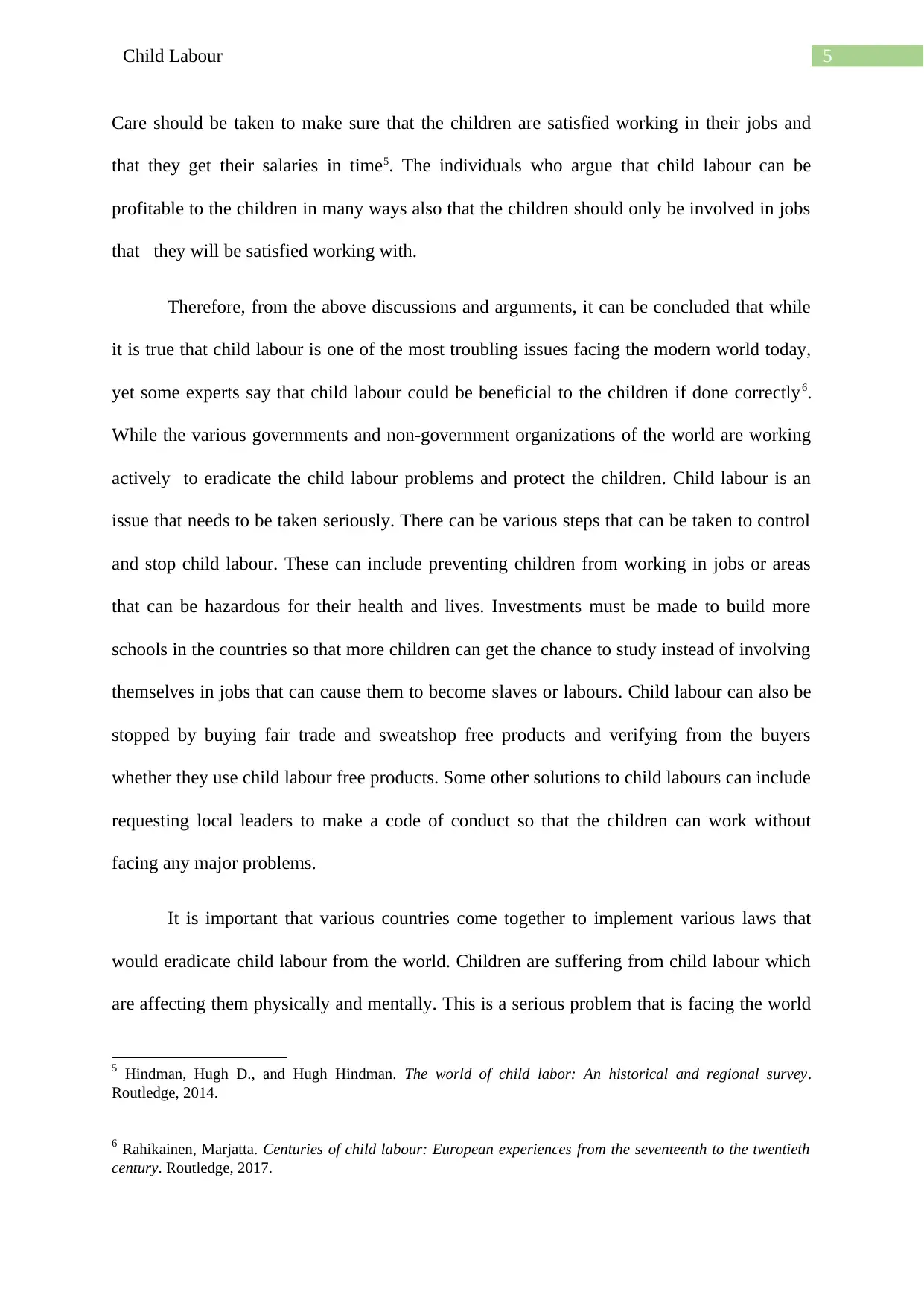
5Child Labour
Care should be taken to make sure that the children are satisfied working in their jobs and
that they get their salaries in time5. The individuals who argue that child labour can be
profitable to the children in many ways also that the children should only be involved in jobs
that they will be satisfied working with.
Therefore, from the above discussions and arguments, it can be concluded that while
it is true that child labour is one of the most troubling issues facing the modern world today,
yet some experts say that child labour could be beneficial to the children if done correctly6.
While the various governments and non-government organizations of the world are working
actively to eradicate the child labour problems and protect the children. Child labour is an
issue that needs to be taken seriously. There can be various steps that can be taken to control
and stop child labour. These can include preventing children from working in jobs or areas
that can be hazardous for their health and lives. Investments must be made to build more
schools in the countries so that more children can get the chance to study instead of involving
themselves in jobs that can cause them to become slaves or labours. Child labour can also be
stopped by buying fair trade and sweatshop free products and verifying from the buyers
whether they use child labour free products. Some other solutions to child labours can include
requesting local leaders to make a code of conduct so that the children can work without
facing any major problems.
It is important that various countries come together to implement various laws that
would eradicate child labour from the world. Children are suffering from child labour which
are affecting them physically and mentally. This is a serious problem that is facing the world
5 Hindman, Hugh D., and Hugh Hindman. The world of child labor: An historical and regional survey.
Routledge, 2014.
6 Rahikainen, Marjatta. Centuries of child labour: European experiences from the seventeenth to the twentieth
century. Routledge, 2017.
Care should be taken to make sure that the children are satisfied working in their jobs and
that they get their salaries in time5. The individuals who argue that child labour can be
profitable to the children in many ways also that the children should only be involved in jobs
that they will be satisfied working with.
Therefore, from the above discussions and arguments, it can be concluded that while
it is true that child labour is one of the most troubling issues facing the modern world today,
yet some experts say that child labour could be beneficial to the children if done correctly6.
While the various governments and non-government organizations of the world are working
actively to eradicate the child labour problems and protect the children. Child labour is an
issue that needs to be taken seriously. There can be various steps that can be taken to control
and stop child labour. These can include preventing children from working in jobs or areas
that can be hazardous for their health and lives. Investments must be made to build more
schools in the countries so that more children can get the chance to study instead of involving
themselves in jobs that can cause them to become slaves or labours. Child labour can also be
stopped by buying fair trade and sweatshop free products and verifying from the buyers
whether they use child labour free products. Some other solutions to child labours can include
requesting local leaders to make a code of conduct so that the children can work without
facing any major problems.
It is important that various countries come together to implement various laws that
would eradicate child labour from the world. Children are suffering from child labour which
are affecting them physically and mentally. This is a serious problem that is facing the world
5 Hindman, Hugh D., and Hugh Hindman. The world of child labor: An historical and regional survey.
Routledge, 2014.
6 Rahikainen, Marjatta. Centuries of child labour: European experiences from the seventeenth to the twentieth
century. Routledge, 2017.
⊘ This is a preview!⊘
Do you want full access?
Subscribe today to unlock all pages.

Trusted by 1+ million students worldwide

6Child Labour
and unless it can be taken into consideration, it can prove to be very dangerous for the future
generation. Especially in Australia, the government should take drastic steps to make sure
that aboriginal and Torres Straight kids are no longer taken into labour and slavery so that no
future generation of kids become known as “stolen generation”. Britain must ensure that there
are more schools so that the children get more time to study instead of working at jobs. More
measures must be made by the United Nation and the International Labour Organization
(ILO) to ensure that child labour is controlled and that children are protected. Africa and
other nations must take measures so that the children do not get abused while working and
that they have to work for as less hours as possible. Hence, this essay proves the fact that is
important to take action immediately to control and stop child labour because once it gets
out of control, it will be very difficult to control the problem7. Moreover, children are
considered to be the “Future Generations” of Earth. Care must be taken to make sure that this
so called “Future Generation” do not turn into more “Stolen Generation”8. Only the children
can carry the future generation forward. If they fall prey to the issue of child labour, that will
be a huge problem for the future generation. So, it is very important that steps must be taken
to control the problem of child labour immediately.
7 Rahikainen, Marjatta. Centuries of child labour: European experiences from the seventeenth to the twentieth
century. Routledge, 2017.
8 Rossi, Arianna, Amy Luinstra, and John Pickles, eds. Towards better work: Understanding labour in apparel
global value chains. Springer, 2014.
and unless it can be taken into consideration, it can prove to be very dangerous for the future
generation. Especially in Australia, the government should take drastic steps to make sure
that aboriginal and Torres Straight kids are no longer taken into labour and slavery so that no
future generation of kids become known as “stolen generation”. Britain must ensure that there
are more schools so that the children get more time to study instead of working at jobs. More
measures must be made by the United Nation and the International Labour Organization
(ILO) to ensure that child labour is controlled and that children are protected. Africa and
other nations must take measures so that the children do not get abused while working and
that they have to work for as less hours as possible. Hence, this essay proves the fact that is
important to take action immediately to control and stop child labour because once it gets
out of control, it will be very difficult to control the problem7. Moreover, children are
considered to be the “Future Generations” of Earth. Care must be taken to make sure that this
so called “Future Generation” do not turn into more “Stolen Generation”8. Only the children
can carry the future generation forward. If they fall prey to the issue of child labour, that will
be a huge problem for the future generation. So, it is very important that steps must be taken
to control the problem of child labour immediately.
7 Rahikainen, Marjatta. Centuries of child labour: European experiences from the seventeenth to the twentieth
century. Routledge, 2017.
8 Rossi, Arianna, Amy Luinstra, and John Pickles, eds. Towards better work: Understanding labour in apparel
global value chains. Springer, 2014.
Paraphrase This Document
Need a fresh take? Get an instant paraphrase of this document with our AI Paraphraser
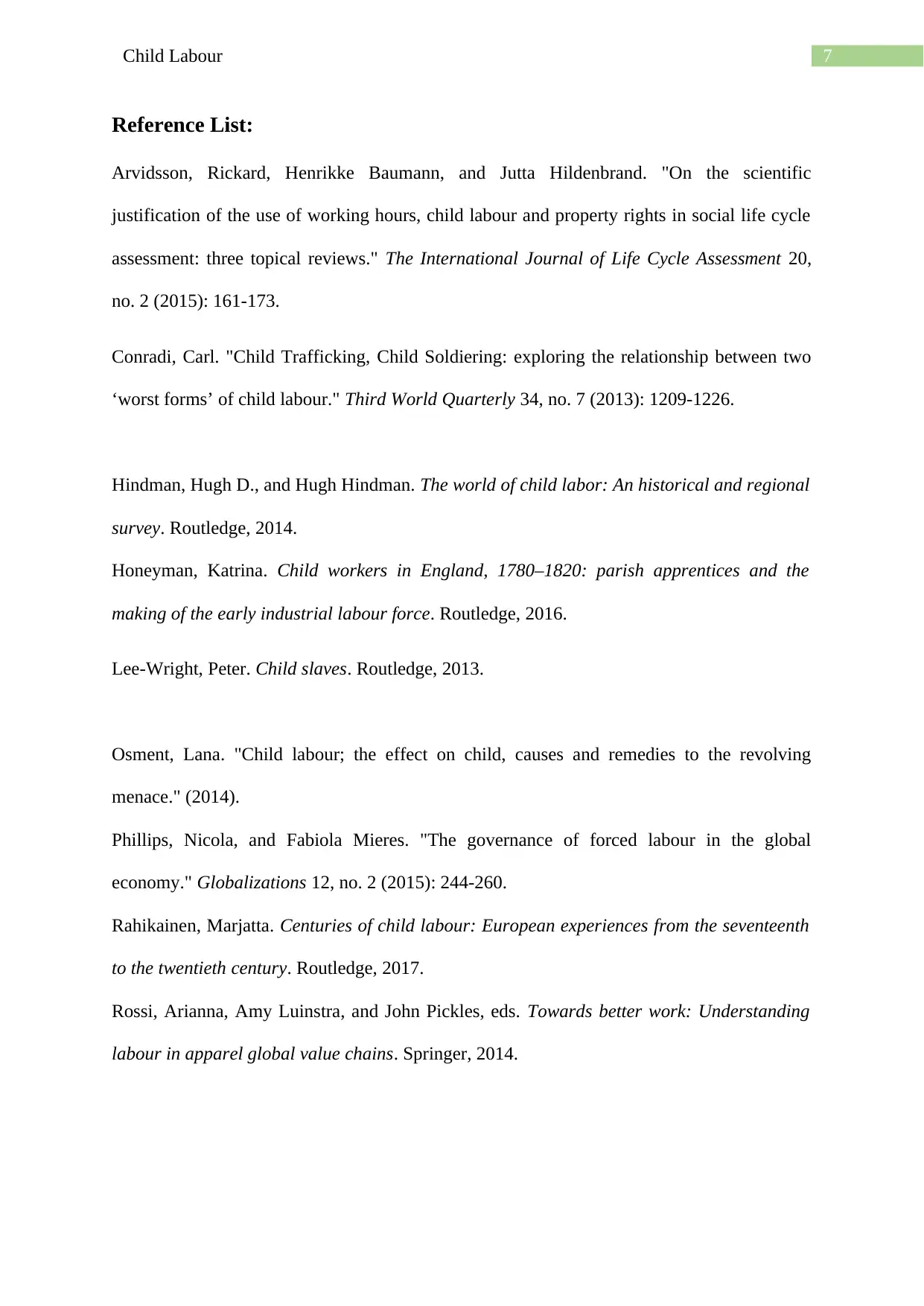
7Child Labour
Reference List:
Arvidsson, Rickard, Henrikke Baumann, and Jutta Hildenbrand. "On the scientific
justification of the use of working hours, child labour and property rights in social life cycle
assessment: three topical reviews." The International Journal of Life Cycle Assessment 20,
no. 2 (2015): 161-173.
Conradi, Carl. "Child Trafficking, Child Soldiering: exploring the relationship between two
‘worst forms’ of child labour." Third World Quarterly 34, no. 7 (2013): 1209-1226.
Hindman, Hugh D., and Hugh Hindman. The world of child labor: An historical and regional
survey. Routledge, 2014.
Honeyman, Katrina. Child workers in England, 1780–1820: parish apprentices and the
making of the early industrial labour force. Routledge, 2016.
Lee-Wright, Peter. Child slaves. Routledge, 2013.
Osment, Lana. "Child labour; the effect on child, causes and remedies to the revolving
menace." (2014).
Phillips, Nicola, and Fabiola Mieres. "The governance of forced labour in the global
economy." Globalizations 12, no. 2 (2015): 244-260.
Rahikainen, Marjatta. Centuries of child labour: European experiences from the seventeenth
to the twentieth century. Routledge, 2017.
Rossi, Arianna, Amy Luinstra, and John Pickles, eds. Towards better work: Understanding
labour in apparel global value chains. Springer, 2014.
Reference List:
Arvidsson, Rickard, Henrikke Baumann, and Jutta Hildenbrand. "On the scientific
justification of the use of working hours, child labour and property rights in social life cycle
assessment: three topical reviews." The International Journal of Life Cycle Assessment 20,
no. 2 (2015): 161-173.
Conradi, Carl. "Child Trafficking, Child Soldiering: exploring the relationship between two
‘worst forms’ of child labour." Third World Quarterly 34, no. 7 (2013): 1209-1226.
Hindman, Hugh D., and Hugh Hindman. The world of child labor: An historical and regional
survey. Routledge, 2014.
Honeyman, Katrina. Child workers in England, 1780–1820: parish apprentices and the
making of the early industrial labour force. Routledge, 2016.
Lee-Wright, Peter. Child slaves. Routledge, 2013.
Osment, Lana. "Child labour; the effect on child, causes and remedies to the revolving
menace." (2014).
Phillips, Nicola, and Fabiola Mieres. "The governance of forced labour in the global
economy." Globalizations 12, no. 2 (2015): 244-260.
Rahikainen, Marjatta. Centuries of child labour: European experiences from the seventeenth
to the twentieth century. Routledge, 2017.
Rossi, Arianna, Amy Luinstra, and John Pickles, eds. Towards better work: Understanding
labour in apparel global value chains. Springer, 2014.
1 out of 8
Related Documents
Your All-in-One AI-Powered Toolkit for Academic Success.
+13062052269
info@desklib.com
Available 24*7 on WhatsApp / Email
![[object Object]](/_next/static/media/star-bottom.7253800d.svg)
Unlock your academic potential
Copyright © 2020–2025 A2Z Services. All Rights Reserved. Developed and managed by ZUCOL.





